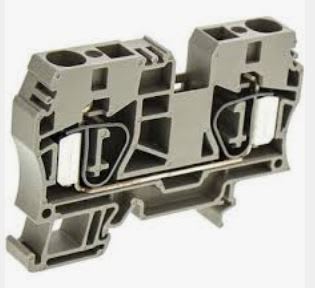Hi all,
During an annually check we have found that inside an ESD marshalling cabinet, one of the two parallel PSU 230VAC/24VDC-40A was not working because the 230 VAC feeder screw terminals and cables (6 mm2) were burnt. The terminal plastic insulation melted, phase and neutral came to contact and short-circuited, which caused the MCB (25A) to trip. The marshalling cabinet environment is kept controlled, no dust, temperature 20..24 degC.
My colleagues think that the cause was a high resistance connection inside the screw terminal blocks.
This marshalling cabinet was running continuously from 2012. Two months before, we were working inside the cabinet (but not on the damaged terminal) without noticing anything strange, so the burnt terminals must have happened in the last 2 months.
The terminals were rated for 50 A. If a well tightened terminal has a resistance of 0,0001 .. 0,001 Ohm , then maximum heat is 0,25 .. 2,5 W.
The PSU current was about 4,5 A so if the resistance from the loose connection increased from 0,001 to 1 Ohm, then the produced heat would be 20 W.
Any comments for this calculation? Does this make sense, or am I missing something?
Is a terminal connection possible to run with no problem for 10+ years and then start to increase its resistance?
What makes the resistance to increase with the time? Is this increase linear or more steeply ?
Are there any articles to explain how this type of fault happens ? I have searched and found only a Wikipedia article which is not very detailed.
Thank you for your feedback!
During an annually check we have found that inside an ESD marshalling cabinet, one of the two parallel PSU 230VAC/24VDC-40A was not working because the 230 VAC feeder screw terminals and cables (6 mm2) were burnt. The terminal plastic insulation melted, phase and neutral came to contact and short-circuited, which caused the MCB (25A) to trip. The marshalling cabinet environment is kept controlled, no dust, temperature 20..24 degC.
My colleagues think that the cause was a high resistance connection inside the screw terminal blocks.
This marshalling cabinet was running continuously from 2012. Two months before, we were working inside the cabinet (but not on the damaged terminal) without noticing anything strange, so the burnt terminals must have happened in the last 2 months.
The terminals were rated for 50 A. If a well tightened terminal has a resistance of 0,0001 .. 0,001 Ohm , then maximum heat is 0,25 .. 2,5 W.
The PSU current was about 4,5 A so if the resistance from the loose connection increased from 0,001 to 1 Ohm, then the produced heat would be 20 W.
Any comments for this calculation? Does this make sense, or am I missing something?
Is a terminal connection possible to run with no problem for 10+ years and then start to increase its resistance?
What makes the resistance to increase with the time? Is this increase linear or more steeply ?
Are there any articles to explain how this type of fault happens ? I have searched and found only a Wikipedia article which is not very detailed.
Thank you for your feedback!


